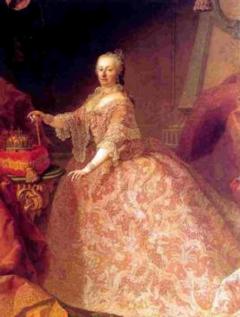Maria Theresia (Maria Theresa)
Archduchess of Austria, queen of Hungary and Bohemia, b. 13 May 1717 (Vienna, Austria), d. 29 November 1780 (Vienna).
 When the only son of the Holy Roman Emperor Charles VI died, Charles remained the only living prince of the Habsburg line. To preserve the dynasty he promulgated the Pragmatic Sanction, a royal act which allowed female succession. The act was grudgingly respected by the other royal houses of Europe while Charles lived; but his death in 1740 immediately started the War of the Austrian Succession, which lasted for eight years.
When the only son of the Holy Roman Emperor Charles VI died, Charles remained the only living prince of the Habsburg line. To preserve the dynasty he promulgated the Pragmatic Sanction, a royal act which allowed female succession. The act was grudgingly respected by the other royal houses of Europe while Charles lived; but his death in 1740 immediately started the War of the Austrian Succession, which lasted for eight years.
Four years earlier in 1736 Charles' eldest daughter Maria Theresia had married Francis Stephen of Lorraine. It was a marriage of love, and French intervention - union of Lorraine with the Habsburg possessions was not considered acceptable - forced Francis Stephen to give up the duchy of Lorraine. The couple had 16 children, 10 of whom survived into adulthood, among them Marie-Antoinette, the queen of France who was executed during the French Revolution.
After her father's death Maria Theresia became Archduchess of Austria and made her husband co-regent. But the law reserved the title of Holy Roman emperor to males, and the European powers elected Charles Albert of Bavaria to that position. Although the title had become more a ceremonial atrribute than an expression of real power, Maria Theresia resented the snub; after Charles Albert's death in 1745 she managed to have the title bestowed on her husband.
Charles VI had exhausted Austria's finances and had left it in a weak position. The War of the Austrian Succession of 1740 - 1748 and the Seven Years' War of 1756 - 1763 against the troops of Frederick the Great meant the loss of the prosperous province of Silesia to Prussia.
Maria Theresia recognized that for Austria to continue to play a role in Europe it had to be less fractionated and required a stronger central authority. She curtailed the powers of the feudal estates and abolished the tax exemptions enjoyed by the large landowners. She separated the judiciary from the political administration. To provide skilled public servants and judges she reorganised the universities by introducing textbooks and reserved the right to veto the election of deans by the faculties.
When Francis died in 1765 Maria Theresia appointed her son Joseph II as co-regent and had him elected holy Roman emperor. Their relationship soon developed into open and permanent conflict. Joseph II was open to new ideas and followed with interest the intellectual developments of the "Enlightenment" in France. Maria Theresia's moves at modernization of the Austrian state were more driven by necessity than by interest in social progress. A pius Catholic, she was intolerant when it came to new ideas. (She also insisted on subordination of the church to state authority and banned witch trials.)
Initially Maria Theresia had invoked the concept of "God-pleasing equality" to curb the powers of the feudal class, without giving much thought to the consequences for the peasants. It was only when famine and severe exploitation by the landowners caused peasant riots in Bohemia that she developed a sense of social responsibility. She wrote: "The peasantry must be able to sustain itself as well as pay taxes" and introduced laws to limit the use of forced labour. She supervised the reorganization of the fledgling public health system, the introduction of a Poor Law and the drafting of a new penal code.
In the end, Maria Theresia gave Austria, a country formed of many people by historical circumstances, a sense of unity and prepared it for the transition into a new order. Some historians see her as "the most human of the Habsburgs."
home
 When the only son of the Holy Roman Emperor Charles VI died, Charles remained the only living prince of the Habsburg line. To preserve the dynasty he promulgated the Pragmatic Sanction, a royal act which allowed female succession. The act was grudgingly respected by the other royal houses of Europe while Charles lived; but his death in 1740 immediately started the War of the Austrian Succession, which lasted for eight years.
When the only son of the Holy Roman Emperor Charles VI died, Charles remained the only living prince of the Habsburg line. To preserve the dynasty he promulgated the Pragmatic Sanction, a royal act which allowed female succession. The act was grudgingly respected by the other royal houses of Europe while Charles lived; but his death in 1740 immediately started the War of the Austrian Succession, which lasted for eight years.